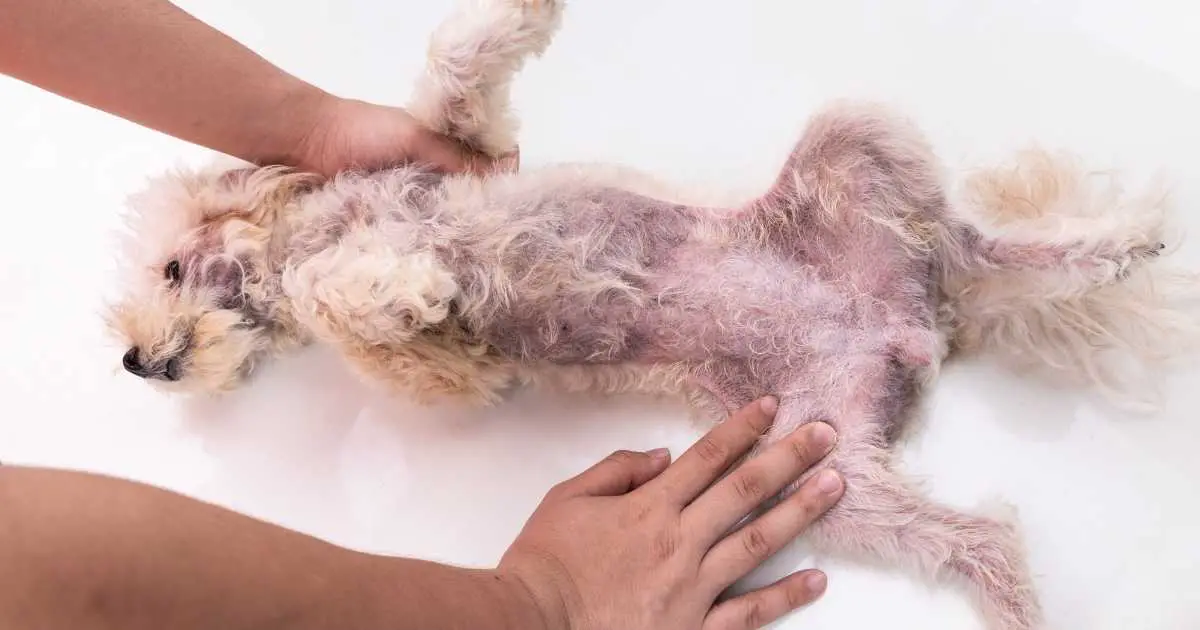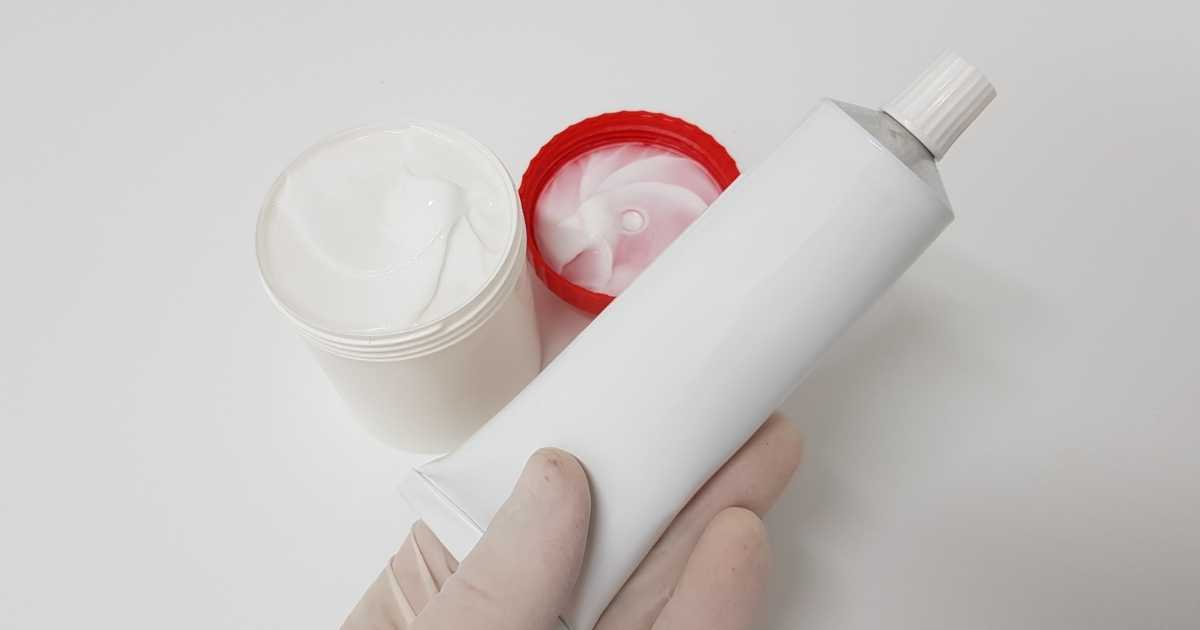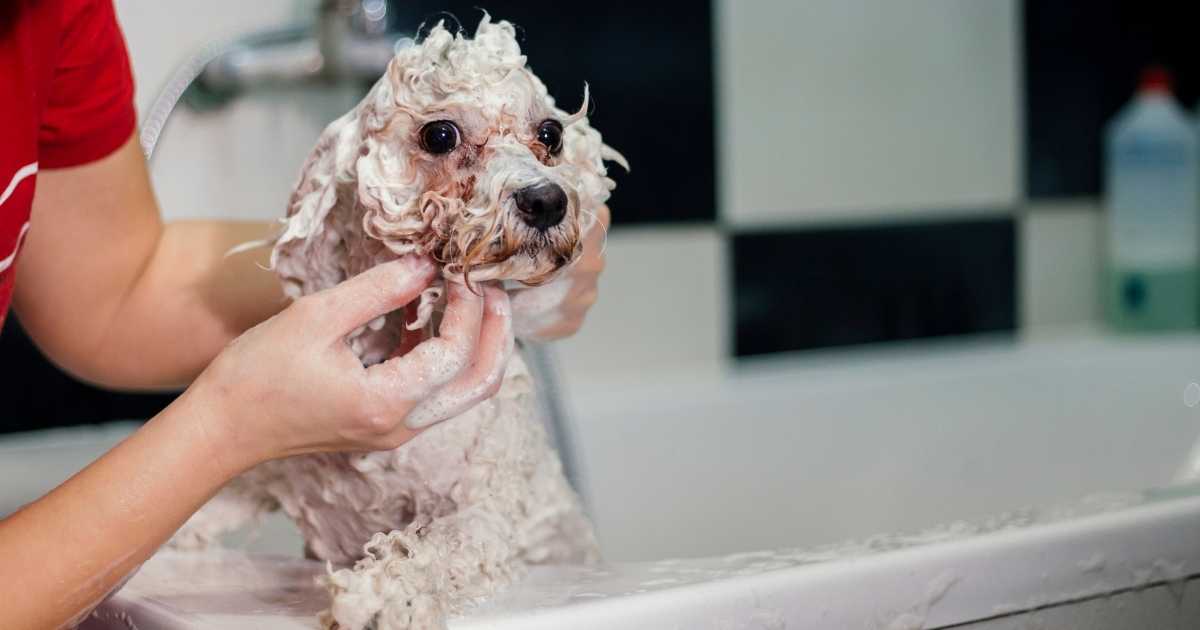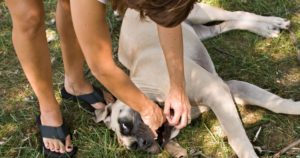If you’ve noticed red, inflamed, and irritated patches on your dog’s skin or your dog has recently been diagnosed with a fungal infection, you might be thinking ‘can I use antifungal cream on my dog?’
In this article we’ll dissect exactly what a fungal infection is and if it actually is safe to use your antifungal cream (or shampoo) on your dog.
What is a Fungal Infection on a Dog?

When we hear or read the word ‘infection’ we mostly associate it with bacteria or viruses, but sometimes fungi can also cause an infection.
Fungi are parasitic and spore-producing organisms that grow on and absorb food from their hosts. Not all fungi species cause infections.
In dogs, a fungal infection is quite common as it occurs due to exposure to the soil/environment or contact with other animals.
Dogs tend to play outside in the dirt and water and come in contact with other animals on walks. So it’s not too difficult to comprehend why fungal infections are common in dogs.
These infections can also occur as the result of an overgrowth of yeast (which is naturally present on your dog’s skin). This is called yeast dermatitis and it’s commonly seen around the ears, nails, or skin folds.
The most notorious skin fungal infections in dogs are ringworm (dermatophytes), yeast dermatitis, and aspergillosis.
Dogs with floppy ears and a lot of hair around their ears are more frequently affected by fungal infections.
What is Antifungal Cream?

Antifungal creams are used topically to treat fungal infections on the skin, scalp, and nails of humans. The cream clears the infection and reduces inflammation, i.e. redness or itchiness.
These creams come in a variety of brands but they have the following active substances:
- Clotrimazole
- Econazole
- Ketoconazole
- Miconazole
- Tioconazole
- Terbinafine
- Amorolfine
Can I Use Antifungal Cream on My Dog?
There are many ointments that are made specifically for dogs, but it is safe to use human antifungal cream on your dog’s skin.
However, you should first do a patch test to check if your dog has any allergic reactions to the cream.
You can test this by applying a small amount of cream to the skin of your dog, preferably somewhere where they can’t reach to scratch, for example, the back of the neck.
Wait approximately 30 minutes and inspect the skin for any redness, flakes, or irritation. If you see none, it is safe to assume your dog will not have an allergic reaction.
Any over-the-counter antifungal creams or yeast creams work well when applied to the inflamed or irritated skin of your dog. These creams soothe the irritation caused by a rash.
Which Antifungal Cream Should I Use on My Dog?
Econazole is great for heat irritations and hotspots, which we discuss later in this article.
Clotrimazole is probably the most common over-the-counter antifungal cream and you could find it in most pharmacies. It’s a great overall cream for fungal infections.
What if My Dog Licks the Antifungal Cream?
Antifungal creams and ointments are not safe for ingestion and can cause some health issues if your dog licks at it.
Your dog might show symptoms like vomiting or diarrhea if they have licked antifungal cream. You should definitely get your dog to a vet if you notice these symptoms after applying antifungal cream.
What if My Dog is Pregnant or Lactating?
If your dog is pregnant or lactating it is not recommended to apply any topical antifungal cream from your pharmacy onto her skin. You should consult with your vet to ensure appropriate medication is applied.
Can I Use Antifungal Shampoo on My Dog?

Unlike antifungal cream, it is not recommended to use human antifungal shampoo on your dog.
The pH balance of a dog’s skin is different from a human’s, so using human shampoo on a dog disrupts the acid mantle on the dog’s skin.
This ultimately leaves them more susceptible to bacteria, fungi, and bacteria. It also dries out their skin, usually causing increased scratching.
We would rather recommend using a product like Veterinary Formula Clinical Care Antiseptic and Antifungal Shampoo or getting a recommendation from your local vet to treat a fungal infection.
Hotspots
Hotspots are patches of red, inflamed skin lesions on your dog’s skin that are usually caused by playing outside in the sun and dirt.
Watch this video of a vet, Greg Martinez, detailing valuable information about hotspots.
Although hotspots are technically a bacterial infection, antifungal creams are great for soothing the irritation and treating them.
Remember to make sure your dog doesn’t lick off the cream.
You should take your dog to your local vet if the hotspot does not improve after using antifungal cream.
How to Prevent Your Dog from Getting an Antifungal Infection
Yeast Infection
If your dog has a high risk of contracting a yeast infection (big floppy ears, excess hair around the ears, or lots of skin folds) there are a few preventative measures that you can take.
Try to keep your pup indoors if it’s extremely humid outside, you should make sure that the skin folds and ears are dry at all times, especially after a bath or a swim.
Also, inspect the nutrients in the food that you give them – check out our articles on the best organic dog food.
Parasitic Fungal Infections
These infections are also common in dogs, especially ringworm. To prevent your dog from contracting ringworm you should limit interaction with other dogs that might be showing signs of a fungal infection.
You should consistently wash your dog’s toys, leash, and collar and consult with your local vet regarding a good quality medicated shampoo to use for your dog.
Final Thoughts
We hope that you found this article helpful if you’ve been asking yourself ‘can I use antifungal cream on my dog’ and are attempting to soothe the irritation of your dog’s fungal infection.
It’s always best to run a product by your vet, even if it’s just a telephone conversation discussing the ingredients. Always remember to do patch tests!






